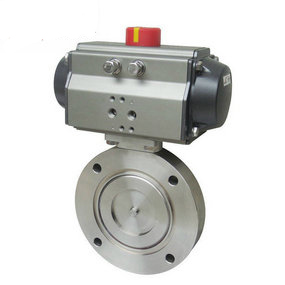What to do if the pneumatic louver type round butterfly valve fails? 2 Results and Discussion 2.1 The microstructure and properties of the coating 2.1 The Al2O3-TiO2 and WC Co cermet coatings are formed by overlapping particles, and the coating structure is compact, without obvious cracks and coarse pores. It is composed of Al2O3, TiO2 and other phases, and also contains a small amount of Fe3O4, which is due to the high temperature of the arc zone and the oxidation of the material during the arc spraying process.
2.2 Friction and wear properties and surface microhardness The microhardness of the cermet coating is significantly higher than that of the matrix. The microhardness (Vickers hardness) of the Al2O3-TiO2 coating is the highest, reaching 1463, while the microhardness (Vickers hardness) of the matrix is only 524. Due to the formation of hard intermetallic compounds such as Al2O3, TiO2, WC and Co2O3 by surface deposition, the surface hardness of the plasma coating is significantly higher than that of the substrate. The wear resistance of the friction pairs of Al2O3-TiO2 and WC Co cermet coatings prepared by plasma spraying is significantly improved compared with that of untreated friction pairs, and the wear resistance of WC Co cermet coatings is slightly better than that of Al2O3-TiO2 cermet coatings, The reason why the plasma sprayed coating has high wear resistance is that it has high microhardness and nanocrystalline particles are dispersed in the coating. The high hardness coating is difficult to plastic deformation, and can not produce obvious brittle peeling under contact. The dispersed nanocrystalline particles have a good dispersion strengthening effect on the coating, Both of them improve the wear resistance of the friction pair.

What are the installation requirements of pneumatic butterfly valve
1. Before installation, check that all parts of the pneumatic butterfly valve are free of missing parts, correct models, sundries in the valve body, and blockage in the solenoid valve and silencer.
2. Place the valve and cylinder in the closed state.
3. Hit the cylinder onto the valve (the installation direction can be parallel or vertical to the valve body), and then check whether the screw hole is aligned without too much deviation. If there is a little deviation, rotate the cylinder body a little, and then tighten the screws.
4. After installation, the pneumatic butterfly valve shall be commissioned (the air supply pressure is 0.4~0.6MPa under normal conditions). During commissioning, the solenoid valve must be opened and closed manually (it can be effective only after the solenoid valve coil is de energized), and the opening and closing of the pneumatic butterfly valve shall be observed. If it is found during commissioning and operation that the valve has some difficulty at the beginning of the opening and closing process, and then it is normal, it is necessary to reduce the stroke of the cylinder (adjust the stroke adjusting screws at both ends of the cylinder a little inward at the same time, and when adjusting, it is necessary to run the valve to the open position, and then turn off and adjust the air source again) until the valve opens and closes smoothly without leakage. It should also be noted that the adjustable silencer can adjust the opening and closing speed of the valve, but it should not be too small, otherwise the valve may not act.
5. The DFA shall be kept dry before installation and shall not be stored in the open air.
6. Before installing the butterfly valve, check the pipeline to ensure that there is no welding slag and other foreign matters in the pipeline.
7. The manual opening and closing resistance of the butterfly valve body is moderate, and the torque of the butterfly valve matches the torque of the selected actuator.
8. The flange specification for butterfly valve connection is correct, and the pipe clamp flange is consistent with the butterfly valve flange standard. It is recommended to use special flange for butterfly valve, and flat welding flange is not allowed.
9. Confirm that the flange welding is correct. Do not weld the flange after the butterfly valve is installed to avoid scalding the rubber parts.
10. The installed pipe flange shall be aligned with the butterfly valve.
11. Install all flange bolts and tighten them by hand to confirm that the butterfly valve is aligned with the flange, and then carefully open and close the butterfly valve to ensure flexible opening and closing.
12. Fully open the valve, use a wrench to tighten the bolts in a diagonal sequence, without washers. Do not tighten the bolts too tightly to prevent serious deformation of the valve ring and excessive opening and closing torque.




